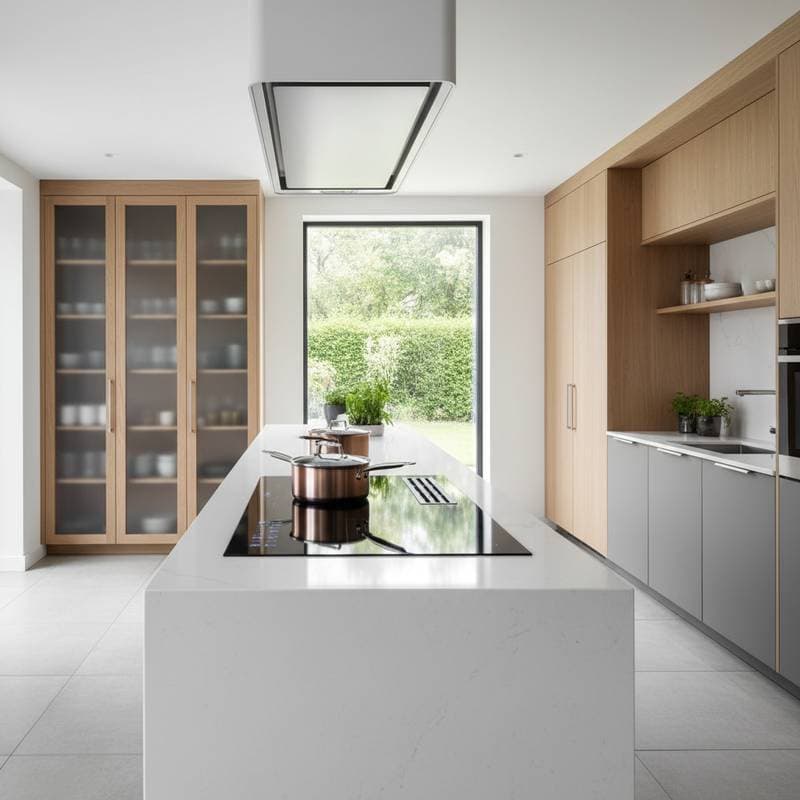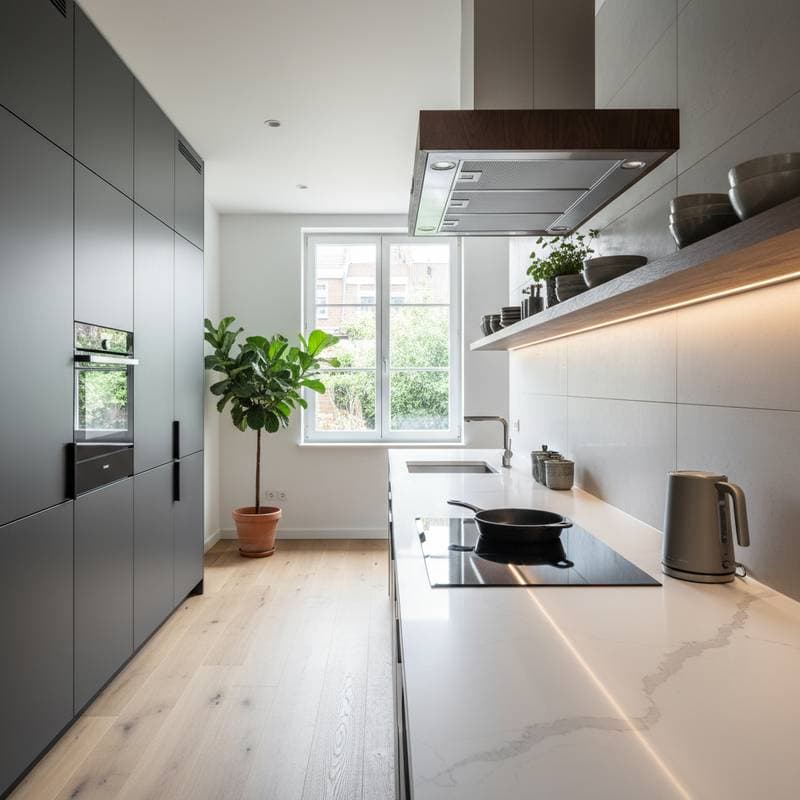Why Japandi Wabi-Sabi Kitchens Dominate 2025
Professionals who remodel kitchens observe a notable evolution in homeowner preferences. Individuals seek warmth, balance, and authenticity rather than glossy perfection or stark minimalism. Japandi and Wabi-Sabi philosophies address these desires precisely. These approaches merge functional simplicity with emotional resonance, positioning them at the forefront of contemporary remodeling discussions.
The surge in popularity stems from more than visual appeal. It reflects a response to modern lifestyles. Homeowners reject environments that appear curated yet lack practicality. They select kitchens that mature elegantly, convey narratives, and foster tranquility in routine tasks. Japandi Wabi-Sabi designs excel in this regard, surpassing other recent trends.
The Core of Japandi Wabi-Sabi
This aesthetic fuses complementary principles. Japandi integrates Japanese minimalism and Scandinavian functionality. Wabi-Sabi introduces reverence for imperfection, transience, and genuineness. The result yields a kitchen that appears deliberate yet flexible.
Key elements characterize an authentic Japandi Wabi-Sabi kitchen:
-
Natural Materials
Select wood, stone, clay, plaster, and linen as primary components. These choices develop patina, texture, and character over time. They enhance rather than deteriorate with use. -
Muted, Earthy Colors
Opt for tones inspired by the natural world, such as sand, smoke, moss, and warm white. These shades promote visual serenity. They allow minor imperfections to integrate seamlessly. -
Simple Lines, Honest Construction
Design cabinetry with straightforward forms and utility in mind. Eliminate elaborate trim or superfluous hardware. Highlight quality through visible joinery and finishes. -
Functional Flow
Emphasize efficiency in the layout. Assign purpose to every space. Incorporate storage subtly and ensure surfaces withstand regular cleaning. -
Visible Aging
Embrace signs of use as integral features. Consider subtle marks on wooden counters or irregular glazes on artisanal tiles. Such details enrich the overall narrative.
This blend of discipline and coziness renders these kitchens inviting. They function as robust, everyday areas free from undue concern.
Common Mistakes to Avoid
Planning a Japandi Wabi-Sabi kitchen requires vigilance against pitfalls that undermine the vision. Experienced remodelers encounter these issues frequently. They often lead to extended timelines and increased expenses.
1. Using Cheap Imitations
Engineered products that simulate natural textures seldom achieve the desired authenticity. Laminate with artificial wood patterns may appear adequate initially. However, genuine oak or ash, complete with natural variations, acquires appealing depth.
2. Overcomplicating the Layout
Simplicity defines this style. Excessive cabinetry, excessive shelving, or ornamental elements disrupt the harmonious flow. Maintain geometric clarity and purpose-led arrangements.
3. Ignoring Texture
Uniform, sleek surfaces fail to convey the essence. Introduce diversity through combinations like smooth plaster against coarse wood or matte tiles paired with brushed metal. These pairings provide dimension and sensory engagement.
4. Inadequate Lighting
Layer illumination to achieve a gentle ambiance. Steer clear of stark ceiling lights. Prioritize warm bulbs and maximize daylight. Subpar schemes diminish even premium materials.
5. Rushing the Finish Work
Craftsmanship forms the foundation. Misaligned edges or uneven applications appear careless. Engage artisans skilled in nuanced execution. Precision, not flawlessness, unlocks the style's charm.
The Financial Side
Homeowners often perceive this aesthetic as premium-priced due to its refined appearance. Costs vary based on execution. Authentic, straightforward materials form the basis, demanding quality without extravagance.
A thoughtfully planned project employs fewer elements, aiding budget control. Allocate resources toward skilled labor or bespoke treatments. Offset expenses by omitting nonessential features.
For resale value, these kitchens attract discerning buyers. Their timeless quality resists obsolescence. Evidence of intentional build elevates property appeal, supporting investment recovery.
Why This Style Will Keep Growing
This movement represents more than a fleeting phase. It corrects prevailing design excesses. Individuals desire lasting, relatable environments over transient novelty. Japandi Wabi-Sabi fosters such bonds, emphasizing sincerity over sterility.
Contractors find these endeavors rewarding. They center on integrity and detail. Each element serves a deliberate function, free from pretense. This authenticity connects deeply with clients, outshining standardized alternatives.
Implementing Your Japandi Wabi-Sabi Kitchen
Approach the project with intention from the outset. Recognize that evolution occurs naturally. Follow these steps to realize the vision:
-
Set Clear Priorities
Identify core values, whether utility, tactile quality, or eco-friendliness. These guide selections throughout. -
Choose Honest Materials
Commit to solid wood, stone, or clay options. Reject synthetic substitutes. True substances establish the aesthetic foundation. -
Work with Skilled Craftspeople
Seek collaborators attuned to refined balance. Verify their portfolio for similar subtlety. -
Plan for the Long Term
Anticipate patina development. Select durable, enhancing finishes. -
Embrace Imperfection
Integrate minor irregularities. They contribute to the space's unique history.
Executed effectively, this kitchen anchors daily existence. It endures gracefully, blending utility with quiet elegance.









